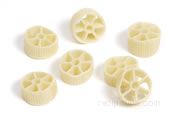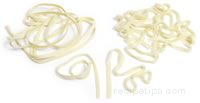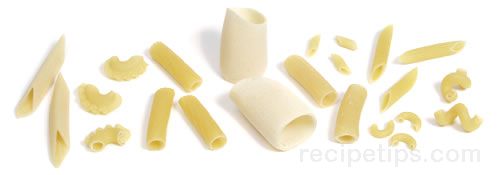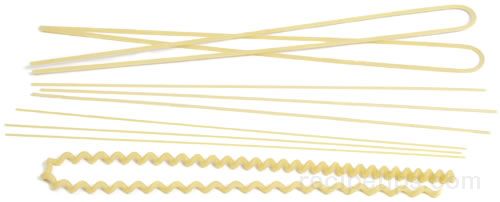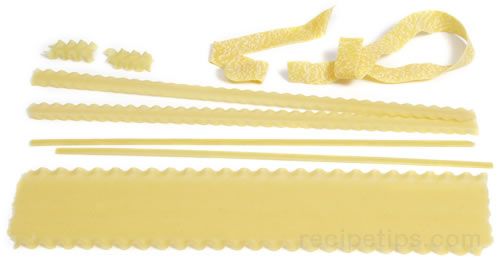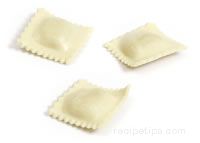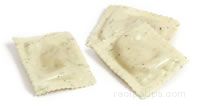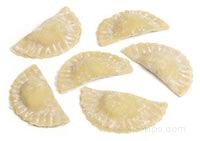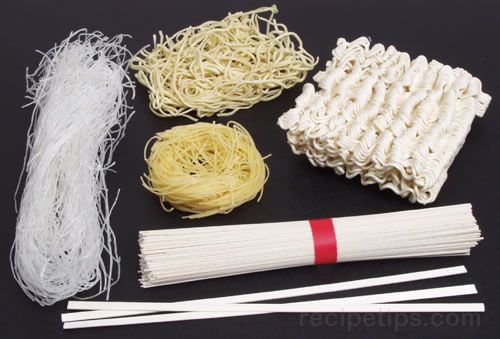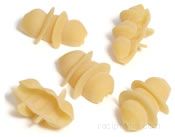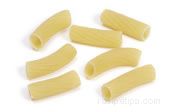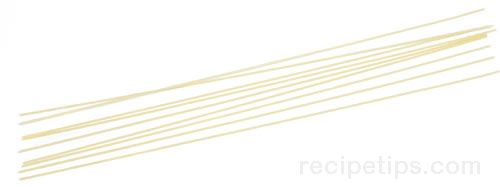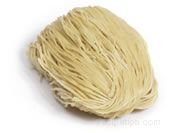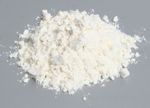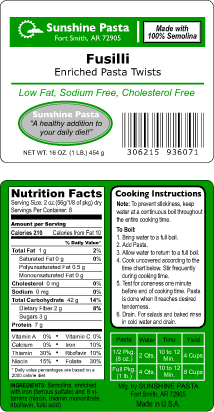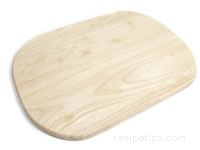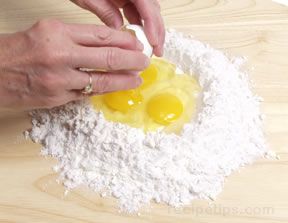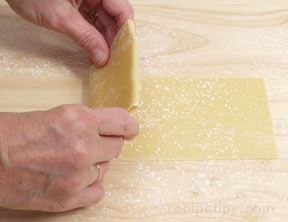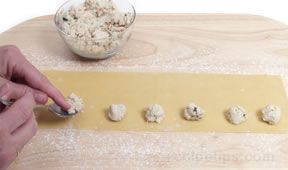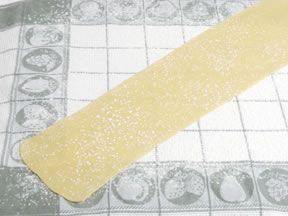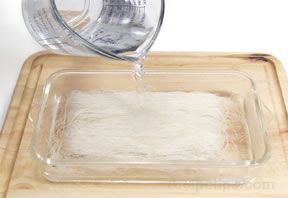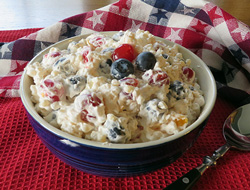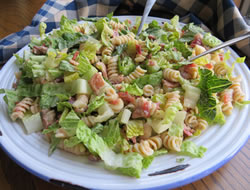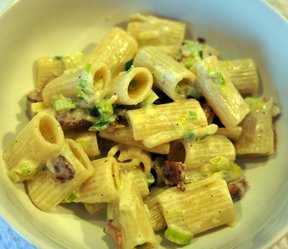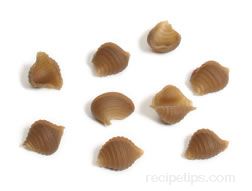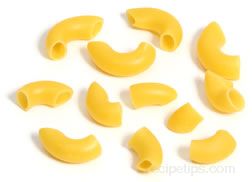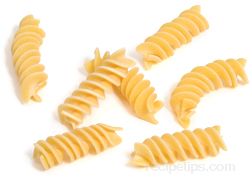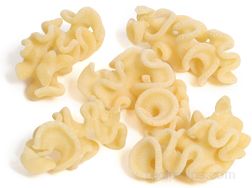Basic Types | Flavors and Colors | Pasta Shapes | Pasta Sauces
Pasta is a basic staple ingredient used in cooking. It is available in hundreds of shapes worldwide and in many different flavors. It is available as dried and fresh pasta. You can also make homemade pasta. There are many ways in which pasta can be used, but it is most popular to eat it topped with a sauce. Many types of pasta can be used as the main ingredient or in smaller amounts as an added ingredient in casseroles, soups, stews, and salads. Some types of pasta do not work well as a main ingredient and are only used as an ingredient in another dish. When pasta is served with just a sauce, it is important to consider what type, shape, and flavor of pasta will be best with the sauce you plan to use. The information below will provide you with a better understanding of the different types of pasta that are available.
|
Dried Pasta Dried pasta is readily available in many sizes and shapes. It is factory made and fully dried before it is packaged. Dried pasta is most often made with just semolina flour, water and salt, but it is also available made from other types of flour and seasoning. It rarely contains eggs so it can be stored indefinitely without refrigerating or freezing. The firmness of dried pasta allows it to be stored easily without damage.
When the same amounts of dried and fresh pasta are cooked, the dried pasta will produce approximately 60% more than the fresh pasta. You will need to take this into consideration if substituting fresh pasta in a recipe that calls for dried pasta. Because of its firm texture, most dried pastas, except for the more delicate sized and shaped types, work well with thick sauces and sauces containing meat and vegetables. Fresh Pasta Fresh pasta is available in a variety of sizes and shapes but not to the extent of dried pasta. It is, however, available in a greater variety of flavors. Fresh pasta most often contains eggs and has high water content, making it necessary to refrigerate or freeze the pasta to keep it from spoiling. The eggs in the pasta brighten its color, add flavor, and give the pasta more nutritional value. Fresh pasta is made daily in Italian specialty stores and is found commercially in food stores both refrigerated and frozen. If refrigerated, it should be used within 3 to 4 days of purchasing it and within approximately one to two months if frozen. Fresh pasta can be dried and stored at room temperature, but it is important that the pasta is completely dried before storing. Fresh pasta is more delicate than dried pasta, making it more difficult to store.
Because fresh pasta does not swell in the same manner as dried pasta you will need approximately 50 percent more fresh pasta to equal the same amount of dried pasta. Fresh pasta's softer texture goes well with lighter sauces, such as tomato sauces, cream sauces and simple sauces made from oil or butter that is flavored with herbs. Making fresh homemade pasta provides an opportunity to create many different flavors of pasta. A variety of flours, such as wheat flour, buckwheat flour, rice flour, soy flour, and oat flour can be used to provide different flavors. Also, other flavoring agents can be used, such as herbs and spices, corn meal, cheese, fruits, chilies, spinach, tomatoes, beets, and carrots. The different flavoring agents will also affect the color of the pasta and its texture. | ||||||||||||
Dried and fresh pasta are available in various flavors and colors. The flavoring agent is the ingredient that generally affects the color of the pasta. An unlimited number of options are available to use as flavoring agents. There are pasta dough ingredients that act as flavoring agents and also extra ingredients that are added to the dough that affect the flavor and color. Some of the common agents that will affect the flavor and color of the pasta are listed below.
|
Flavors and Colors of Pasta - Pasta Dough Ingredients | |||
|
Flavoring Agent |
Description | Flavor | Color |
| Unbleached White Flour | A standard baking flour made from red winter wheat. Unbleached flour has not gone through all the processing that bleached flour has, so it produces a firmer dough. It is lighter than whole wheat flour and produces pasta dough that is easy to work with. | Basic pasta | Creamy beige |
|
Semolina Flour |
Flour that is finely ground from hard durum winter wheat. Semolina flour is used to make most dried pastas. It contains a fair amount of gluten, which provides elasticity to the dough, allowing the dough to be formed into a large variety of shapes. | Basic pasta | Creamy beige |
|
Whole Wheat Flour |
Flour made from whole wheat grain. Whole wheat flour is available in several different grinds and will provide heavier textured pasta than the unbleached flour. The coarser grinds are best used for flat noodles, whereas, the finer grinds can be used for most any shapes. Additional water is generally required when using whole wheat flour. | Nuttier than basic pasta | Medium tan to light brown |
| Buckwheat Flour | Flour made from buckwheat seeds, which have been toasted. This is a heavy flour that produces dough that is tender but slightly gritty. To lighten its texture and provide smoother dough, it is sometimes mixed with lighter flour, such as unbleached white or fine ground whole wheat. The dough cracks easily so it is best used for thick wide noodles. | Strong nutty flavor | Light to medium brown |
| Corn Flour | Flour made from corn, which provides a pasta that is wheat and gluten free. Corn flour produces a product that can be used by consumers that have an intolerance to wheat products. It provides a flavorful pasta alternative. The texture of pasta made from corn flour can be slightly grainier than wheat pasta. | Corn | Bright yellow |
| Oat Flour | High-fiber flour made from oats. It has a coarse texture and can be used in the same manner that coarsely ground whole wheat flour is used for making pasta. | Nutty | Tan to medium brown |
| Brown Rice Flour | Flour made from rice that has only the inedible hull removed. This flour is high in fiber and resembles pasta dough made from whole wheat flour, except the dough made from brown rice flour is a little stickier. Pasta dough made with brown rice flour works best for making flat noodles. | Slightly sweet | Tan to light brown |
| Rice Flour | Flour finely milled from non-glutinous rice. Rice flour is used to make thin white translucent Chinese noodles. The noodles are deep-fried to produce crunchy strands, or soaked in warm water and then added to soups or used in stir-frying. | Mild | Translucent white |
| Mung Bean Threads | Mung bean threads produce a gelatin-like noodle that has a translucent appearance. It is cooked and used in the same manner as rice flour noodles. The noodles are often called bean threads or cellophane noodles and are widely used in Asian cooking. | Flavorless, absorbs the flavor of the foods it is combined with | Translucent white |
| Corn Meal | Used to add nutrition and a distinct flavor to pasta. Corn meal is always mixed sparingly with flour so the pasta dough does not become too grainy. If the dough is too grainy it becomes difficult to roll out or extrude from a machine. Corn meal dough works best for making flat noodles. Color Note: The amount and type of corn meal added will determine how much affect it will have on the color. The corn meal may just add specks of yellow, white or blue to the color. |
Corn | The type of flour used in making the dough determines the base color. See: Color Note. |
|
Flavors and Colors of Pasta - Ingredients Added to the Pasta Dough | |||
|
Flavoring Agent |
Description | Flavor | Color |
| Spinach | Finely chopped spinach is added to the pasta dough according to the recipe instructions. | Mild spinach | Medium to dark green |
|
Broccoli |
Finely chopped broccoli is added to the pasta dough according to the recipe instructions. | Mild broccoli | Medium to dark green |
|
Tomato |
Tomato paste is added to the pasta dough according to the recipe instructions. | Mild tomato | Light reddish-orange to dark reddish-orange |
| Beets | Cooked beets, which are used mostly to add color, are pureed and strained, then added to the pasta dough according to the recipe instructions. | Slight difference from plain pasta | Deep pink to dark red |
| Carrot | Pureed carrots or carrot juice is added to the pasta dough according to the recipe instructions. | Strong carrot | Orange |
| Red Bell Pepper | Roasted bell peppers are pureed and added according to the recipe instructions. | Slightly sweet | Bright orangish-red |
| Chile Pepper |
Different varieties of chile peppers, such as jalapeño, cayenne, poblano, and Serrano, can be used for chile pepper pasta. The peppers should have the seeds removed and then be chopped into fine pieces or pureed. Dried chile peppers are also used. Flavor Note: The flavor will vary in strength according to the degree of hotness of the variety of chile pepper used. |
A sharp biting flavor See: Flavor Note | Color will vary according to the variety of pepper used |
| Squid Ink | Squid or cuttlefish ink is strained from the eye "bags or sacs" of the squid or cuttlefish. It is added to the pasta recipe for a unique flavor and color. | Mild seafood | Dark gray, almost black |
| Garlic | Crushed garlic cloves are added according to the recipe instructions. | Garlic | Creamy beige |
| Garlic and Herbs | Crushed garlic cloves and one or more herbs, such as sage, thyme, parsley, chives, rosemary, tarragon, basil, and oregano, are added to the pasta dough. | Spicy Garlic | Creamy beige with green flecks |
| Curry | Curry powder, which is a spice blend that is generally composed of cumin, turmeric, coriander, ground red pepper, and cloves, is added to the pasta dough to provide a distinct flavor. | Spicy | Tint of burnt orange |
| Saffron | Saffron is added to pasta dough to give it a distinct flavor and color. | Spicy, mildly bitter | Bright yellowish-gold |
| Lemon | Lemon pasta contains lemon juice and/or lemon zest, which provides a very mild lemon flavor to the pasta. | Mildly tart, lemon | Light yellow |
| Straw- berry |
The strawberries are simmered to soften them and then the juice is strained from the strawberries and added to the pasta dough. | Mild straw- berry |
Dull pale red |
| Chocolate | Unsweetened cocoa powder and sugar are added to the dough to give it a mildly sweet chocolate flavor. It works well in sweet pasta dishes. | Mild Chocolate | Brown |
| Although there are many pasta flavor options that provide a variety of tastes, the pasta sauce or ingredients that are mixed with the pasta or noodles will have the biggest effect on the taste of the finished dish. The lighter or simpler the sauce is, the more the flavor of the pasta will come through. |
Pasta is available in many different forms and sizes. The majority of pasta shapes that are available originated in Italy but they have also been created in other parts of the world. Many types of noodles have been created in Asian countries. Certain shapes and sizes are used for specific purposes, while others can be used in several different manners. Shown below are the basic categories in which pasta shapes are found.
|
Shaped pastas are available in many different sizes and specific shapes. They include shapes that resemble shells, bow ties, spirals, snails, wheels and radiators. Shaped pastas are generally found dried. The smaller shaped pastas work well with a simple sauce but most shaped pastas can be paired with a chunkier sauce because they are sturdy enough to hold up with the other ingredients. They are also used in pasta salads and casseroles. See Pasta Products - Shaped Pasta for more details on specific shapes and sizes. | ||||||
|
Tubular Pasta Tubular pastas are any pastas that are in the shape of a tube. They are available in many different sizes and shapes. Some tubes are long and narrow while others are short and wide. They are found with smooth or grooved exteriors and their ends are cut straight or at an angle. They are often served with a heavy sauce, which holds well in the hollows of the pasta tubes. Tubular pastas are also used in salads and casseroles. Some of the larger tubes that have a wide opening can be stuffed with meat and/or cheese and then baked. See Pasta Products - Tubular Pasta for more details on specific shapes and sizes. | ||||||
|
Strand Pasta Noodles Pasta strands are long rods of pasta, which are generally round, but they are available in a square rod also. The basic difference from one variety to the next is the thickness of the strands. The thicker strands work well with a heavier sauce while the thin varieties are better with a more delicate sauce. See Pasta Products - Strand Pasta for more details on specific shapes and sizes. | ||||||
|
Ribbon Pasta Noodles Ribbon pastas consist of flat strands of pasta, which are available in different lengths, widths and thickness. Some are short and wide, while others are long and narrow. Ribbon pasta can have straight or wavy edges. Many varieties are available fresh and dried. The dried ribbons are generally used with a thick, heavier sauce and the fresh ribbons are served with a more delicate sauce. See Pasta Products - Ribbon Pasta for more details on specific shapes and sizes. | ||||||
|
Soup Pasta Soup pastas consist of pasta shapes that range in size from small to very tiny. The larger of the soup pastas are used in thicker based soups and the tiny and smaller pasta shapes are used in light or broth based soups. Some of the soup pastas are also used in pasta salads. Soup pastas include many shapes, such as round balls, thin strands, tubes, rings, grain-shapes, bow ties and stars. See Pasta Products - Soup Pasta for more details on specific shapes and sizes. | ||||||
|
Stuffed Pasta
Stuffed pastas consist of fresh pasta sheets that are stuffed with a filling. The pasta sheets are folded over and sealed or another sheet is placed on top and the edges are sealed after the filling has been added. Some sheets are folded over the filling and then twisted to form a little hat shaped pasta. Stuffed pastas are formed in different shapes, such as squares, circles, triangles and half moons. They are stuffed with a variety of fillings, which consist of a mixture of ingredients, such as meats, cheeses, herbs, mushrooms, and vegetables. Stuffed pastas are first cooked and then generally served with a light sauce. They can also be served in a broth or added to a salad after they have been cooked. See Pasta Products - Stuffed Pasta for more details on specific shapes and sizes. | ||||||
|
Asian Noodles
Asian noodles consist of strands that vary in shape, width and length. Many Asian noodles are very long in length, symbolizing longevity. They are also found as thin straight sticks, flat strands, round strands, and wavy strands. The noodles are made from various flours, such as wheat flour, rice flour, potato flour, soybean flour, and mung bean flour. Some Asian noodles are made with eggs but many are not. Various noodles are available fresh and dried, but some are only found in Asian markets.
Asian noodles are a variety of colors, such as translucent white, opaque white, cream, yellow, tan and brown. The ingredients used, in the dough affects the color of the noodle. Asian noodles are eaten hot and cold, and are used in soups, salads, stir-fries, and other Asian dishes. See Pasta Products - Asian Noodles for more details on specific shapes and sizes. When Asian noodles are referred to as Lo-Mein or Chow Mein, the noodles used can actually be the same type of noodle. The difference between Lo-Mein and Chow Mein noodles is the way in which it is prepared and served. The Lo-Mein noodles are boiled and added to the other ingredients in the dish at the end of the cooking process. The Chow-Mein noodles are boiled and then served with stir-fry ingredients on tops, which have been cooked separately from the noodles. |
Although there are many different types of pasta available with many different flavors, the majority of the taste from a pasta dish comes from the sauce. The lighter the sauce is the more noticeable the pasta's taste will be. The size and shape of the pasta or noodles should be taken into consideration when determining the type of sauce to use. There are some general guidelines to follow when selecting a sauce, but do not be afraid to experiment with combining different shapes and sauces to see what appeals to your personal taste. Some general guidelines are shown below.
| Matching Pasta to Sauce | |
|
| |
| Examples: | Conchiglie, farfalle, fusilli, gemelli, gnocchetti, gramigna, lumache, lumaconi, orecchiette, radiatori, route, rotini, and trenne |
|
Sauce: |
Thick tomato sauces, meat sauces, chunky sauces, and cheese sauces |
Tubular Pasta | |
| Examples: | Canneroni, cannolicchi, cavatappi, garganelli, macaroni, maccheroncelli, manicotti, paccheri, penne, rigatoni, tortiglioni, and ziti |
| Sauce: | Thick tomato sauces, meat sauces, chunky sauces, and thick cream sauces |
Strand Pasta | |
| Examples: | Angel hair, capellini, chitarra, fedelini, spaghetti, and vermicelli |
| Sauce: | Light tomato sauces, butter based sauces, light oil based sauces, and light cream based sauces. |
Ribbon Pasta | |
| Examples: | Fettuccine, lasagne, linguine, pappardelle, riginette, tagliatelle, and trenette |
| Sauce: | For the wider dried pastas - meat sauces, thick tomato sauces, and thick cream sauces. For narrow or fresh pastas - Light tomato sauces, butter based sauces, light oil based sauces, and light cream based sauces. |
Soup Pasta | |
| Examples: | Acini di pepe, alphabets, anellini, conchigliette, ditali, farfalline, orzo, pastine, risi, stele, stortini, and tubetti |
| Sauce: | Light sauces, mainly used in broth or soups with a light base. |
Stuffed Pasta | |
| Examples: | Agnolotti, pansotti, ravioli, tortelli, and tortellini |
| Sauce: | Light tomato sauce, light cream based sauce, and broth |
Asian Noodles | |
| Examples: | Asian wheat noodles, Chinese egg noodles, Asian rice noodles, cellophane noodles, cornstarch noodles, seaweed noodles, and soba noodles |
| Sauce: | Generally not eaten with a sauce. Used in stir-fries, soups and salads. |

